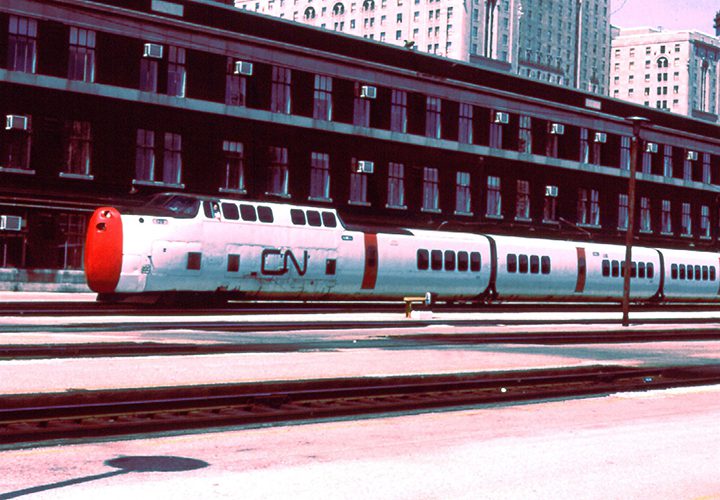Inducted in 2010
The TurboTrain was an early high-speed, gas turbine train manufactured by United Aircraft Corporation that operated in Canada between 1968 and 1982. It was one of the first gas turbine powered trains for passenger traffic, and was also one of the first tilting trains to enter service.
United Aircraft used C&O patents from the 1950s in order develop turbine power in place of the original diesel. The engine cars had three engine bays on either side of the car and could mount two to six turbines depending on the needs of the carrier.
The engine was so much smaller and lighter than the diesels they replaced that the power cars would have ended up being relatively small in comparison to the passenger cars. This “extra space” was used by extending the locomotives out to be longer than the passenger cars to add additional seating, and extended the dome containing the driving controls to included additional seating there as well.
In 1966 Canadian National Railways ordered five Turbos of seven cars each for the Montreal-Toronto service. The Canadian trains were built by Montreal Locomotive Works, with their engines supplied by UAC’s Canadian division.
The Turbo’s first demonstration run in December 1968 included a large press and electronic media contingent. Unfortunately, the Turbo hit a truck at a level crossing outside Kingston. Despite the concerns that lightweight trains like the Turbo would be dangerous in collisions, the train remained upright and largely undamaged. Beams just behind the nose, designed for this purpose, limited the damage to the fiberglass clamshell doors and some bent metal. The train was returned from repairs within a week.
Initial commercial service started soon after. On its first westbound run the Turbo hit 104 mph (167 km/h) only 10 minutes outside of Dorval, and topped out at 167 mph (269 km/h) near Gananoque, Ontario.
The three rebuilt 9-car sets entered service for CN in late 1973. CN ran the Turbos from Toronto-Montreal-Toronto with stops at Dorval, Quebec, Kingston, Ontario and Guildwood, Ontario on the Quebec City-Windsor Corridor. The trip took 3 hours and 59 minutes downtown-to-downtown. Turbo service was about a full hour faster than CN’s previous express trains, the “Rapido”.
CN operated the Turbos until 1978, when their passenger operations were taken over by VIA Rail, who continued the service. The Turbo’s final run was on October 31, 1982. Although they had an early reputation for unreliability, according to CN’s records, the rebuilt TurboTrains had an availability rate of over 97%.


